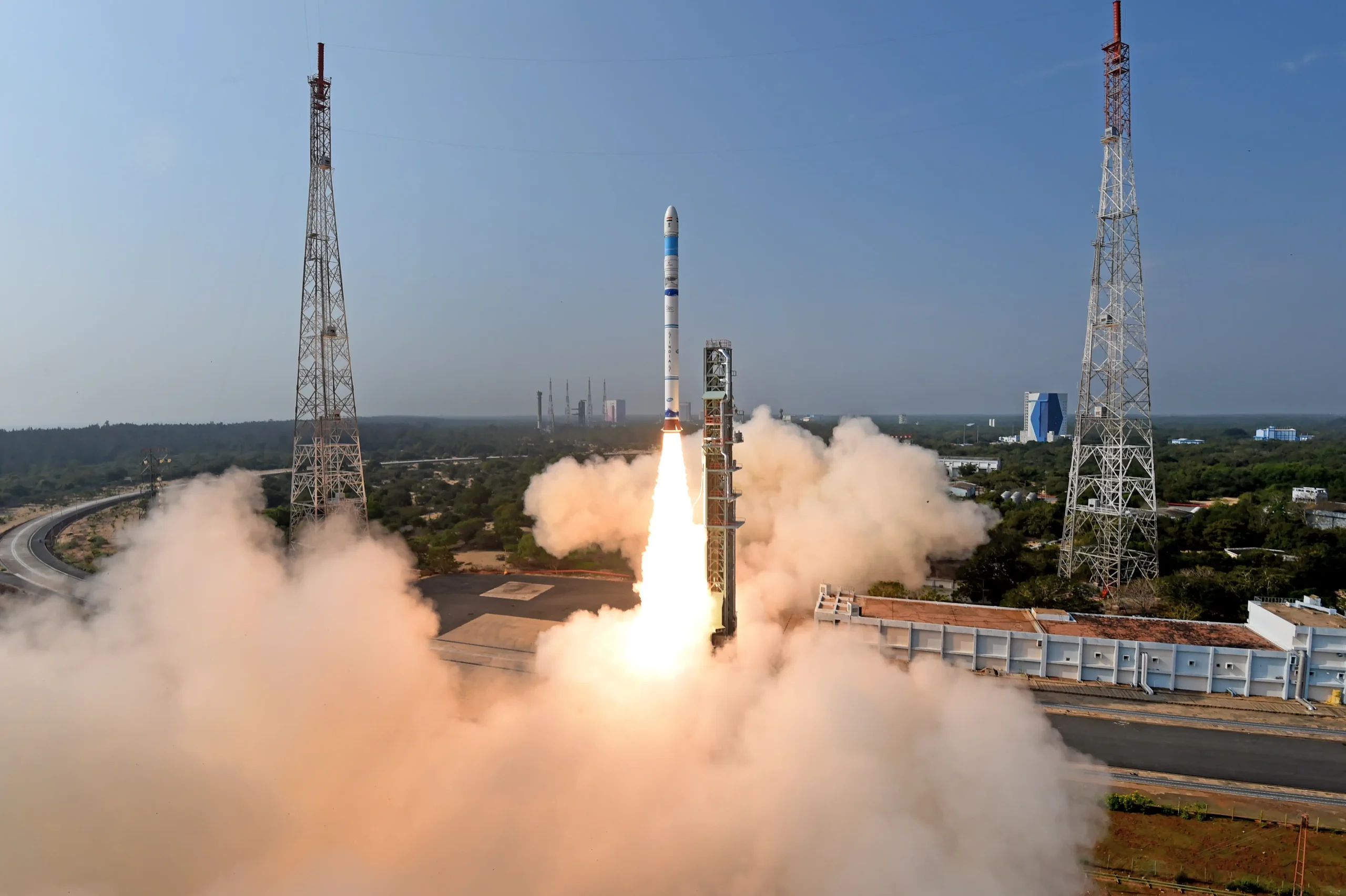
Development of Soorya Rocket by ISRO

With the launch of the Soorya rocket, the Indian Space Research Organization (ISRO) has made a major advancement in its capacity for space research. Future ISRO missions, such as human spaceflights, deep space research, and the delivery of large payloads into different orbits, are expected to heavily rely on the Soorya rocket.
Goals and Perspective
The main goal of the Soorya rocket’s development is to increase ISRO’s cargo capacity and reach beyond Earth’s orbit. This rocket is intended to support India’s human spaceflight program by facilitating human missions and enabling the launch of bigger and more advanced satellites.
Technical Details
Capacity of Payload
One of the most potent launchers ISRO has ever created, the Soorya rocket has a significant payload capacity. Up to 40 tons of payload can be transported to low Earth orbit (LEO) and 10 tons to geostationary transfer orbit (GTO) with this configuration. This potential is much more than that of the GSLV Mk III, ISRO’s workhorse now in use, which can deliver about 4 tons to GTO and about 10 tons to LEO.
Phases and Motor
The three stages of the Soorya rocket use cutting-edge propulsion technology in each other:
1. First Stage: Solid rocket boosters power the first stage, which provides the first push needed for liftoff. Designed to provide strong thrust throughout the first part of the flight, these rockets are some of the biggest that ISRO has ever produced.
2. Second Stage: A combination of cryogenic and liquid engines power this stage. Hypergolic propellants, which ignite upon contact, are used in the liquid engines to ensure efficiency and dependability. Higher specific impulse is provided by the cryogenic engines, which use liquid oxygen and hydrogen to increase the rocket’s overall efficiency.
3. Third Stage: Designed to provide the cargo the last push it needs to enter the intended orbit, the third stage is fully cryogenic. The sophisticated propulsion system of this stage guarantees accurate orbital insertion, which is essential for sensitive payloads and human missions.
Applications for Soorya Rockets
Missions in Human Space
The Soorya rocket is primarily used to assist ISRO’s human spaceflight program. The rocket is a great option for launching crewed spacecraft because of its huge payload capacity and dependable motor systems. In order to take Indian astronauts into space, the Gaganyaan mission will be launched using the Soorya rocket. This mission will open doors for India’s next human space exploration projects.
Satellite Installation
Because the Soorya rocket can lift huge payloads into different orbits, it can be used to launch massive satellites into different orbits. This covers satellites used for scientific study, communication, and Earth observation. Through the use of these satellites, ISRO will be able to improve its capacities in scientific research, meteorological forecasting, disaster management, and telecommunications.
Deep Space Investigation
In addition, the Soorya rocket will be essential to ISRO’s deep space exploration programmes. Larger scientific instruments and exploration modules can be carried by the rocket thanks to its high payload capacity, allowing for more thorough research of far-off celestial entities. This contains prospective space missions that could further humanity’s knowledge of the solar system and the cosmos by visiting the Moon, Mars, and other planets.
Missions Away from Earth
The Soorya rocket’s development is in line with ISRO’s goal of enhancing its capacity for interplanetary exploration. The rocket is appropriate for launching interplanetary probes and landers due to its sturdy construction and strong propulsion systems. Through these missions, ISRO will be able to investigate planets, moons, and other celestial bodies, advancing both science and technology.
ISRO’s also developing RLV technology for its future Human Missions
In order to facilitate future human missions, the Indian Space Research Organization (ISRO) is actively constructing a Reusable Launch Vehicle (RLV). By enabling the reuse of essential parts, this cutting-edge spacecraft seeks to lower the cost of space travel while enhancing the sustainability and effectiveness of space research initiatives. The RLV is being extensively tested and improved by ISRO scientists and engineers to guarantee its dependability and safety for astronaut transportation. India’s space program has advanced significantly with this breakthrough, demonstrating the country’s dedication to improving human spaceflight capabilities.
Launch Sites and Infrastructure
Start Up Complexes
The Soorya rocket’s size and power need ISRO to upgrade its current launch complexes. The Satish Dhawan Space Centre (SDSC) SHAR at Sriharikota will serve as the main launch pad for the Soorya rocket. Modern facilities are already present at SDSC SHAR, and more are being done to accommodate the needs of the Soorya rocket.
Facilities for Assembly and Testing
In order to guarantee the highest level of precision in the manufacturing and integration of the Soorya rocket’s components, ISRO is also upgrading its assembly and testing facilities. Large clean rooms, integration structures, and testing stands big enough to handle the rocket’s complexity are among these facilities.
Cooperation and Global Alliances
Global Collaboration
In order to create the Soorya rocket, international space agencies and organizations are collaborating. ISRO is making use of international prowess in space mission planning, propulsion systems, and rocket technology. This partnership guarantees the application of cutting-edge technologies and best practices, augmenting the Soorya rocket’s total capabilities.
Services for Commercial Launch
The Soorya rocket will be made available to foreign clients as a commercial launch service in addition to being used in ISRO missions. This is in line with ISRO’s objective to lead the space sector globally. The rocket is a desirable choice for launching commercial satellites, scientific instruments, and exploration missions because to its large payload capacity and dependability.
upcoming prospects
Technological Developments in Propulsion
ISRO is making use of international prowess in space mission planning, propulsion systems, and rocket technology. This partnership guarantees the application of cutting-edge technologies and best practices, augmenting the Soorya rocket’s total capabilities.
Services for Commercial Launch
The Soorya rocket will be made available to foreign clients as a commercial launch service in addition to being used in ISRO missions. This is in line with ISRO’s objective to lead the space sector globally. The rocket is a desirable choice for launching commercial satellites, scientific instruments, and exploration missions because to its large payload capacity and dependability.
upcoming prospects
Technological Developments in Propulsion
ISRO is always striving to improve propulsion technologies in order to increase the performance of the Soorya rocket. Research and development on reusable rockets is part of this.
In summary
The Soorya rocket’s construction is a significant step toward ISRO’s and India’s space exploration goals. The Soorya rocket will be essential to ISRO’s upcoming missions because of its large payload capacity, cutting-edge propulsion systems, and range of uses. With its ability to launch human spacecraft, install massive satellites, the Soorya rocket is set to make a big impact on space science and technology.
With the Soorya rocket, India will be able to expand its space capabilities and make a valuable contribution to the international space community because to ISRO’s dedication to innovation, cooperation, and technological advancement. As the construction of the Soorya rocket continues, it will surely open up new avenues for space research and solidify India’s position as a major player in the international space arena.





